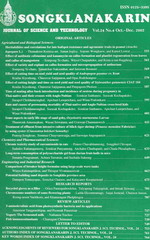ThaiScience
ThaiScience
SONGKLANAKARIN JOURNAL OF SCIENCE & TECHNOLOGY
Volume 42, No. 03, Month MAY, Year 2020, Pages 608 - 614
Intraocular transmissible venereal tumors in dogs a retrospective review of 21 cases
Natthanet Sritrakoon, Phudit Maneesaay, Chaiyan Kasorndorkbua, Supreeya Srisampan, Charuwan Wongsali, Sunee Kunakornsawat, Aree Thayananuphat
Abstract Download PDF
Twenty-nine canine intraocular transmissible venereal tumor (TVT) tissue samples from 21 dogs diagnosed between 2008 and 2014 were reviewed retrospectively. The following clinical data were compared: patient signalment; onset of clinical signs; ophthalmic signs; location of intraocular lesion; duration of unilateral intraocular TVT to bilateral intraocular TVT during the two-year follow-up period; and treatment. Thirty-eight percent (8/21) of the dogs with intraocular TVT eventually had bilateral intraocular TVT within two years. Seventy-five percent (6/8) of the dogs with bilateral intraocular TVT had initially presented with a unilateral lesion. Two dogs that presented with intraocular TVT had no history of genital or extragenital TVT. Chemotherapy did not lead to complete remission of intraocular TVT in contrast to genital and extragenital TVT. Enucleation was performed for all affected eyes. The spread of genital/extragenital TVT to unilateral or bilateral intraocular TVT should be considered and monitored for at least 24 months or longer.
Keywords
dog, eye, intraocular, transmissible venereal tumorSONGKLANAKARIN JOURNAL OF SCIENCE & TECHNOLOGY
Published by : Prince of Songkla University
Contributions welcome at : http://rdo.psu.ac.th
